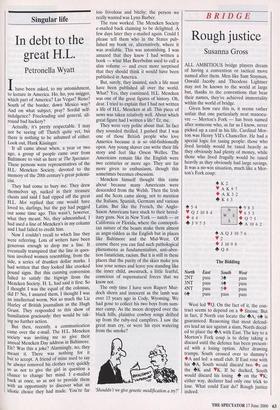BRIDGE
Rough justice
Susanna Gross
ALL AMBITIOUS bridge players dream of having a convention or tactical move named after them. Men like Sam Stayman, Oswald Jacoby and Theodore Lightner may not be known to the world at large but, thanks to the conventions that bear their names, they've achieved immortality within the world of bridge.
Given how rare this is, it seems rather unfair that one particularly neat manoeu- vre — Morton's Fork — has been named after someone who, as far as I know, never picked up a card in his life. Cardinal Mor- ton was Henry VII's Chancellor. He had a special logic for taxing people: those who lived lavishly would be taxed heavily as they obviously had plenty of money, while those who lived frugally would be taxed heavily as they obviously had large savings. It was a no-win situation, much like a Mor- ton's Fork coup: 4 5 4 • Q J 10 8 4 • 6 4 4 I' 9 7 5 4 K 2 ✓ A K 9 7 • A K 3 2
• K 4 3
4 9 8 3
• 6 5 3
• 7 5
# A 10 6 2
WE 4 A Q J 10 7 6 P 2
• J 10 9 8
+ 08 The Bidding North East South West 2NT pass 34 pass 3NT pass 44 pass 4NT pass 5* pass 64 pass pass pass West led Q. On the fact of it, the con- tract seems to depend on a • finesse. But in fact, if North can locate the +A, 64 is guaranteed. Reasoning that most defend- ers lead an ace against a slam, North decid- ed to place the •A with East. The key to a Morton's Fork coup is to delay taking a discard until the defence has been present- ed with a losing option. After drawing trumps, South crossed over to dummy's • A and led a small club. If East rose with his •A, South would discard two 4IFs on the •K and IRK. If he ducked, South would discard his losing • on the IIK; either way, declarer had only one trick to lose. What could East do? Rough justice indeed.










































































 Previous page
Previous page